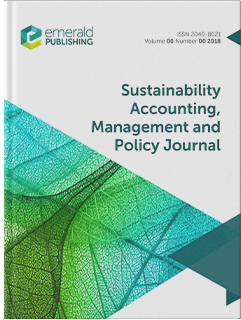
Sustainability Accounting, Management and Policy Journal
Please note, the journal seeks to obtain a minimum of three reviewers per paper or two reviewers plus feedback from an Associate Editor in addition to inform the Editor’s decision. Papers that do not meet the quality criteria, author guidelines and/or editorial scope are desk rejected. The journal acceptance rate is below 10% and the desk rejection rate is approximately 70%.
Before you start
For queries relating to the status of your paper pre decision, please contact the Editor or Journal Editorial Office. For queries post acceptance, please contact the Supplier Project Manager. These details can be found in the Editorial Team section.
Author responsibilities
Our goal is to provide you with a professional and courteous experience at each stage of the review and publication process. There are also some responsibilities that sit with you as the author. Our expectation is that you will:
- Respond swiftly to any queries during the publication process.
- Be accountable for all aspects of your work. This includes investigating and resolving any questions about accuracy or research integrity
- Treat communications between you and the journal editor as confidential until an editorial decision has been made.
- Read about our research ethics for authorship. These state that you must:
- Include anyone who has made a substantial and meaningful contribution to the submission (anyone else involved in the paper should be listed in the acknowledgements).
- Exclude anyone who hasn’t contributed to the paper, or who has chosen not to be associated with the research.
- In accordance with COPE’s position statement on AI tools, Large Language Models cannot be credited with authorship as they are incapable of conceptualising a research design without human direction and cannot be accountable for the integrity, originality, and validity of the published work. The author(s) must describe the content created or modified as well as appropriately cite the name and version of the AI tool used; any additional works drawn on by the AI tool should also be appropriately cited and referenced. Standard tools that are used to improve spelling and grammar are not included within the parameters of this guidance. The Editor and Publisher reserve the right to determine whether the use of an AI tool is permissible.
- If your article involves human participants, you must ensure you have considered whether or not you require ethical approval for your research, and include this information as part of your submission. Find out more about informed consent.
Generative AI usage key principles
- Copywriting any part of an article using a generative AI tool/LLM would not be permissible, including the generation of the abstract or the literature review, for as per Emerald’s authorship criteria, the author(s) must be responsible for the work and accountable for its accuracy, integrity, and validity.
- The generation or reporting of results using a generative AI tool/LLM is not permissible, for as per Emerald’s authorship criteria, the author(s) must be responsible for the creation and interpretation of their work and accountable for its accuracy, integrity, and validity.
- The in-text reporting of statistics using a generative AI tool/LLM is not permissible due to concerns over the authenticity, integrity, and validity of the data produced, although the use of such a tool to aid in the analysis of the work would be permissible.
- Copy-editing an article using a generative AI tool/LLM in order to improve its language and readability would be permissible as this mirrors standard tools already employed to improve spelling and grammar, and uses existing author-created material, rather than generating wholly new content, while the author(s) remains responsible for the original work.
- The submission and publication of images created by AI tools or large-scale generative models is not permitted.
Research and publishing ethics
Our editors and employees work hard to ensure the content we publish is ethically sound. To help us achieve that goal, we closely follow the advice laid out in the guidelines and flowcharts on the COPE (Committee on Publication Ethics) website.
We have also developed our research and publishing ethics guidelines. If you haven’t already read these, we urge you to do so – they will help you avoid the most common publishing ethics issues.
A few key points:
- Any manuscript you submit to this journal should be original. That means it should not have been published before in its current, or similar, form. Exceptions to this rule are outlined in our pre-print and conference paper policies. If any substantial element of your paper has been previously published, you need to declare this to the journal editor upon submission. Please note, the journal editor may use Crossref Similarity Check to check on the originality of submissions received. This service compares submissions against a database of 49 million works from 800 scholarly publishers.
- Your work should not have been submitted elsewhere and should not be under consideration by any other publication.
- If you have a conflict of interest, you must declare it upon submission; this allows the editor to decide how they would like to proceed. Read about conflict of interest in our research and publishing ethics guidelines.
- By submitting your work to Emerald, you are guaranteeing that the work is not in infringement of any existing copyright.
Third party copyright permissions
Prior to article submission, you need to ensure you’ve applied for, and received, written permission to use any material in your manuscript that has been created by a third party. Please note, we are unable to publish any article that still has permissions pending. The rights we require are:
- Non-exclusive rights to reproduce the material in the article or book chapter.
- Print and electronic rights.
- Worldwide English-language rights.
- To use the material for the life of the work. That means there should be no time restrictions on its re-use e.g. a one-year licence.
We are a member of the International Association of Scientific, Technical, and Medical Publishers (STM) and participate in the STM permissions guidelines, a reciprocal free exchange of material with other STM publishers. In some cases, this may mean that you don’t need permission to re-use content. If so, please highlight this at the submission stage.
Please take a few moments to read our guide to publishing permissions to ensure you have met all the requirements, so that we can process your submission without delay.
Open access submissions and information
All our journals currently offer two open access (OA) publishing paths; gold open access and green open access.
If you would like to, or are required to, make the branded publisher PDF (also known as the version of record) freely available immediately upon publication, you can select the gold open access route once your paper is accepted.
If you’ve chosen to publish gold open access, this is the point you will be asked to pay the APC (article processing charge). This varies per journal and can be found on our APC price list or on the editorial system at the point of submission. Your article will be published with a Creative Commons CC BY 4.0 user licence, which outlines how readers can reuse your work.
Alternatively, if you would like to, or are required to, publish open access but your funding doesn’t cover the cost of the APC, you can choose the green open access, or self-archiving, route. As soon as your article is published, you can make the author accepted manuscript (the version accepted for publication) openly available, free from payment and embargo periods.
You can find out more about our open access routes, our APCs and waivers and read our FAQs on our open research page.
Transparency and Openness Promotion (TOP) guidelines
We are a signatory of the Transparency and Openness Promotion (TOP) Guidelines, a framework that supports the reproducibility of research through the adoption of transparent research practices. That means we encourage you to:
- Cite and fully reference all data, program code, and other methods in your article.
- Include persistent identifiers, such as a Digital Object Identifier (DOI), in references for datasets and program codes. Persistent identifiers ensure future access to unique published digital objects, such as a piece of text or datasets. Persistent identifiers are assigned to datasets by digital archives, such as institutional repositories and partners in the Data Preservation Alliance for the Social Sciences (Data-PASS).
- Follow appropriate international and national procedures with respect to data protection, rights to privacy and other ethical considerations, whenever you cite data. For further guidance please refer to our research and publishing ethics guidelines. For an example on how to cite datasets, please refer to the references section below.
Prepare your submission
Manuscript support services
We are pleased to partner with Editage, a platform that connects you with relevant experts in language support, translation, editing, visuals, consulting, and more. After you’ve agreed a fee, they will work with you to enhance your manuscript and get it submission-ready.
This is an optional service for authors who feel they need a little extra support. It does not guarantee your work will be accepted for review or publication.
Manuscript requirements
Before you submit your manuscript, it’s important you read and follow the guidelines below. You will also find some useful tips in our structure your journal submission how-to guide.
|
Format |
Article files should be provided in Microsoft Word format While you are welcome to submit a PDF of the document alongside the Word file, PDFs alone are not acceptable. LaTeX files can also be used but only if an accompanying PDF document is provided. Acceptable figure file types are listed further below. |
|
Article length / word count |
Articles should be between 10000 and 12000 words in length. This includes all text, for example, the structured abstract, references, all text in tables, and figures and appendices. Please allow 280 words for each figure or table. |
|
Article title |
A concisely worded title should be provided. |
|
Author details |
The names of all contributing authors should be added to the ScholarOne submission; please list them in the order in which you’d like them to be published. Each contributing author will need their own ScholarOne author account, from which we will extract the following details:
In multi-authored papers, it’s important that ALL authors that have made a significant contribution to the paper are listed. Those who have provided support but have not contributed to the research should be featured in an acknowledgements section. You should never include people who have not contributed to the paper or who don’t want to be associated with the research. Read about our research ethics for authorship. |
|
Biographies and acknowledgements |
If you want to include these items, save them in a separate Microsoft Word document and upload the file with your submission. Where they are included, a brief professional biography of not more than 100 words should be supplied for each named author. |
|
Research funding |
Your article must reference all sources of external research funding in the acknowledgements section. You should describe the role of the funder or financial sponsor in the entire research process, from study design to submission. |
|
Structured abstract |
All submissions must include a structured abstract, following the format outlined below. These six sub-headings and their accompanying explanations must always be included:
The following sub-heading is optional and can be included, if applicable:
The maximum length of your abstract should be 250 words in total, including keywords and article classification (see the sections below). |
|
Keywords |
Your submission should include up to 12 appropriate and short keywords that capture the principal topics of the paper. Our Creating an SEO-friendly manuscript how to guide contains some practical guidance on choosing search-engine friendly keywords. Please note, while we will always try to use the keywords you’ve suggested, the in-house editorial team may replace some of them with matching terms to ensure consistency across publications and improve your article’s visibility. |
|
Article classification |
During the submission process, you will be asked to select a type for your paper; the options are listed below. If you don’t see an exact match, please choose the best fit:
You will also be asked to select a category for your paper. The options for this are listed below. If you don’t see an exact match, please choose the best fit: Research paper. Reports on any type of research undertaken by the author(s), including:
Viewpoint. Covers any paper where content is dependent on the author's opinion and interpretation which are supported by analysis of evidence. Technical paper. Describes and evaluates technical products, processes or services. Conceptual paper. Focuses on developing hypotheses and is usually discursive. Covers philosophical discussions and comparative studies of other authors’ work and thinking. Case study. Describes actual interventions or experiences within organizations. It can be subjective and doesn’t generally report on research. Also covers a description of a legal case or a hypothetical case study used as a teaching exercise. Literature review. This category should only be used if the main purpose of the paper is to annotate and/or critique the literature in a particular field. It could be a selective bibliography providing advice on information sources, or the paper may aim to cover the main contributors to the development of a topic and explore their different views. General review. Provides an overview or historical examination of some concept, technique or phenomenon. Papers are likely to be more descriptive or instructional (‘how to’ papers) than discursive. |
|
Headings |
Headings must be concise, with a clear indication of the required hierarchy. |
|
Notes/endnotes |
Notes or endnotes should only be used if absolutely necessary. They should be identified in the text by consecutive numbers enclosed in square brackets. These numbers should then be listed, and explained, at the end of the article. |
|
Figures |
All figures (charts, diagrams, line drawings, webpages/screenshots, and photographic images) should be submitted electronically. Both colour and black and white files are accepted.
|
|
Tables |
Tables should be typed and submitted in a separate file to the main body of the article. The position of each table should be clearly labelled in the main body of the article with corresponding labels clearly shown in the table file. Tables should be numbered consecutively in Roman numerals (e.g. I, II, etc.). |
|
Supplementary files |
Where tables, figures, appendices, and other additional content are supplementary to the article but not critical to the reader’s understanding of it, you can choose to host these supplementary files alongside your article on Insight, Emerald’s content hosting platform, or on an institutional or personal repository. All supplementary material must be submitted prior to acceptance. If you choose to host your supplementary files on Insight, you must submit these as separate files alongside your article. Files should be clearly labelled in such a way that makes it clear they are supplementary; Emerald recommends that the file name is descriptive and that it follows the format ‘Supplementary_material_appendix_1’ or ‘Supplementary tables’. All supplementary material must be mentioned at the appropriate moment in the main text of the article, there is no need to include the content of the file but only the file name. A link to the supplementary material will be added to the article during production, and the material will be made available alongside the main text of the article at the point of EarlyCite publication. Please note that Emerald will not make any changes to the material; it will not be copyedited, typeset, and authors will not receive proofs. Emerald therefore strongly recommends that you style all supplementary material ahead of acceptance of the article. Emerald Insight can host the following file types and extensions:
If you choose to use an institutional or personal repository, you should ensure that the supplementary material is hosted on the repository ahead of submission, and then include a link only to the repository within the article. It is the responsibility of the submitting author to ensure that the material is free to access and that it remains permanently available. Please note that extensive supplementary material may be subject to peer review; this is at the discretion of the journal Editor and dependent on the content of the material (for example, whether including it would support the reviewer making a decision on the article during the peer review process). |
|
References |
All references in your manuscript must be formatted using one of the recognised Harvard styles. You are welcome to use the Harvard style Emerald has adopted – we’ve provided a detailed guide below. Want to use a different Harvard style? That’s fine, our typesetters will make any necessary changes to your manuscript if it is accepted. Please ensure you check all your citations for completeness, accuracy and consistency. Emerald’s Harvard referencing style References to other publications in your text should be written as follows:
A few other style points. These apply to both the main body of text and your final list of references.
At the end of your paper, please supply a reference list in alphabetical order using the style guidelines below. Where a DOI is available, this should be included at the end of the reference. |
|
For books |
Surname, initials (year), title of book, publisher, place of publication. e.g. Harrow, R. (2005), No Place to Hide, Simon & Schuster, New York, NY. |
|
For book chapters |
Surname, initials (year), "chapter title", editor's surname, initials (Ed.), title of book, publisher, place of publication, page numbers. e.g. Calabrese, F.A. (2005), "The early pathways: theory to practice – a continuum", Stankosky, M. (Ed.), Creating the Discipline of Knowledge Management, Elsevier, New York, NY, pp.15-20. |
|
For journals |
Surname, initials (year), "title of article", journal name, volume issue, page numbers. e.g. Capizzi, M.T. and Ferguson, R. (2005), "Loyalty trends for the twenty-first century", Journal of Consumer Marketing, Vol. 22 No. 2, pp.72-80. |
|
For published |
Surname, initials (year of publication), "title of paper", in editor’s surname, initials (Ed.), title of published proceeding which may include place and date(s) held, publisher, place of publication, page numbers. e.g. Wilde, S. and Cox, C. (2008), “Principal factors contributing to the competitiveness of tourism destinations at varying stages of development”, in Richardson, S., Fredline, L., Patiar A., & Ternel, M. (Ed.s), CAUTHE 2008: Where the 'bloody hell' are we?, Griffith University, Gold Coast, Qld, pp.115-118. |
|
For unpublished |
Surname, initials (year), "title of paper", paper presented at [name of conference], [date of conference], [place of conference], available at: URL if freely available on the internet (accessed date). e.g. Aumueller, D. (2005), "Semantic authoring and retrieval within a wiki", paper presented at the European Semantic Web Conference (ESWC), 29 May-1 June, Heraklion, Crete, available at: http://dbs.uni-leipzig.de/file/aumueller05wiksar.pdf (accessed 20 February 2007). |
|
For working papers |
Surname, initials (year), "title of article", working paper [number if available], institution or organization, place of organization, date. e.g. Moizer, P. (2003), "How published academic research can inform policy decisions: the case of mandatory rotation of audit appointments", working paper, Leeds University Business School, University of Leeds, Leeds, 28 March. |
|
For encyclopaedia entries |
Title of encyclopaedia (year), "title of entry", volume, edition, title of encyclopaedia, publisher, place of publication, page numbers. e.g. Encyclopaedia Britannica (1926), "Psychology of culture contact", Vol. 1, 13th ed., Encyclopaedia Britannica, London and New York, NY, pp.765-771. (for authored entries, please refer to book chapter guidelines above) |
|
For newspaper |
Surname, initials (year), "article title", newspaper, date, page numbers. e.g. Smith, A. (2008), "Money for old rope", Daily News, 21 January, pp.1, 3-4. |
|
For newspaper |
Newspaper (year), "article title", date, page numbers. e.g. Daily News (2008), "Small change", 2 February, p.7. |
|
For archival or other unpublished sources |
Surname, initials (year), "title of document", unpublished manuscript, collection name, inventory record, name of archive, location of archive. e.g. Litman, S. (1902), "Mechanism & Technique of Commerce", unpublished manuscript, Simon Litman Papers, Record series 9/5/29 Box 3, University of Illinois Archives, Urbana-Champaign, IL. |
|
For electronic sources |
If available online, the full URL should be supplied at the end of the reference, as well as the date that the resource was accessed. Surname, initials (year), “title of electronic source”, available at: persistent URL (accessed date month year). e.g. Weida, S. and Stolley, K. (2013), “Developing strong thesis statements”, available at: https://owl.english.purdue.edu/owl/resource/588/1/ (accessed 20 June 2018) Standalone URLs, i.e. those without an author or date, should be included either inside parentheses within the main text, or preferably set as a note (Roman numeral within square brackets within text followed by the full URL address at the end of the paper). |
|
For data |
Surname, initials (year), title of dataset, name of data repository, available at: persistent URL, (accessed date month year). e.g. Campbell, A. and Kahn, R.L. (2015), American National Election Study, 1948, ICPSR07218-v4, Inter-university Consortium for Political and Social Research (distributor), Ann Arbor, MI, available at: https://doi.org/10.3886/ICPSR07218.v4 (accessed 20 June 2018) |
Submit your manuscript
There are a number of key steps you should follow to ensure a smooth and trouble-free submission.
Double check your manuscript
Before submitting your work, it is your responsibility to check that the manuscript is complete, grammatically correct, and without spelling or typographical errors. A few other important points:
- Give the journal aims and scope a final read. Is your manuscript definitely a good fit? If it isn’t, the editor may decline it without peer review.
- Does your manuscript comply with our research and publishing ethics guidelines?
- Have you cleared any necessary publishing permissions?
- Have you followed all the formatting requirements laid out in these author guidelines?
- Does the manuscript contain any information that might help the reviewer identify you? This could compromise the anonymous peer review process. A few tips:
- If you need to refer to your own work, use wording such as ‘previous research has demonstrated’ not ‘our previous research has demonstrated’.
- If you need to refer to your own, currently unpublished work, don’t include this work in the reference list.
- Any acknowledgments or author biographies should be uploaded as separate files.
- Carry out a final check to ensure that no author names appear anywhere in the manuscript. This includes in figures or captions.
You will find a helpful submission checklist on the website Think.Check.Submit.
The submission process
All manuscripts should be submitted through our editorial system by the corresponding author.
The only way to submit to the journal is through the journal’s ScholarOne site as accessed via the Emerald website, and not by email or through any third-party agent/company, journal representative, or website. Submissions should be done directly by the author(s) through the ScholarOne site and not via a third-party proxy on their behalf.
A separate author account is required for each journal you submit to. If this is your first time submitting to this journal, please choose the Create an account or Register now option in the editorial system. If you already have an Emerald login, you are welcome to reuse the existing username and password here.
Please note, the next time you log into the system, you will be asked for your username. This will be the email address you entered when you set up your account.
Don't forget to add your ORCiD ID during the submission process. It will be embedded in your published article, along with a link to the ORCiD registry allowing others to easily match you with your work.
Don’t have one yet? It only takes a few moments to register for a free ORCiD identifier.
Visit the ScholarOne support centre for further help and guidance.
What you can expect next
You will receive an automated email from the journal editor, confirming your successful submission. It will provide you with a manuscript number, which will be used in all future correspondence about your submission. If you have any reason to suspect the confirmation email you receive might be fraudulent, please contact our Rights team on [email protected]
Post submission
Review and decision process
Each submission is checked by the editor. At this stage, they may choose to decline or unsubmit your manuscript if it doesn’t fit the journal aims and scope, or they feel the language/manuscript quality is too low.
If they think it might be suitable for the publication, they will send it to at least two independent referees for double anonymous peer review. Once these reviewers have provided their feedback, the editor may decide to accept your manuscript, request minor or major revisions, or decline your work.
When you submit your paper, either the Editor or and Associate Editor will invite referees. They aim to get three reviews for each paper. They strive to get authors feedback quickly, given that they want their research to have a practice and policy impact to achieve sustainable development. To achieve this they ask reviewers to return their reviews within four weeks.
This journal offers an article transfer service. If the editor decides to decline your manuscript, either before or after peer review, they may offer to transfer it to a more relevant Emerald journal in this field. If you accept, your ScholarOne author account, and the accounts of your co-authors, will automatically transfer to the new journal, along with your manuscript and any accompanying peer review reports. However, you will still need to log in to ScholarOne to complete the submission process using your existing username and password. While accepting a transfer does not guarantee the receiving journal will publish your work, an editor will only suggest a transfer if they feel your article is a good fit with the new title.
While all journals work to different timescales, the goal is that the editor will inform you of their first decision within 60 days.
During this period, we will send you automated updates on the progress of your manuscript via our submission system, or you can log in to check on the current status of your paper. Each time we contact you, we will quote the manuscript number you were given at the point of submission. If you receive an email that does not match these criteria, it could be fraudulent and we recommend you email [email protected].
If your submission is accepted
Open access
Once your paper is accepted, you will have the opportunity to indicate whether you would like to publish your paper via the gold open access route.
If you’ve chosen to publish gold open access, this is the point you will be asked to pay the APC (article processing charge). This varies per journal and can be found on our APC price list or on the editorial system at the point of submission. Your article will be published with a Creative Commons CC BY 4.0 user licence, which outlines how readers can reuse your work.
Copyright
All accepted authors are sent an email with a link to a licence form. This should be checked for accuracy, for example whether contact and affiliation details are up to date and your name is spelled correctly, and then returned to us electronically. If there is a reason why you can’t assign copyright to us, you should discuss this with your journal content editor. You will find their contact details on the editorial team section above.
Proofing and typesetting
Once we have received your completed licence form, the article will pass directly into the production process. We will carry out editorial checks, copyediting, and typesetting and then return proofs to you (if you are the corresponding author) for your review. This is your opportunity to correct any typographical errors, grammatical errors or incorrect author details. We can’t accept requests to rewrite texts at this stage.
When the page proofs are finalised, the fully typeset and proofed version of record is published online. This is referred to as the EarlyCite version. While an EarlyCite article has yet to be assigned to a volume or issue, it does have a digital object identifier (DOI) and is fully citable. It will be compiled into an issue according to the journal’s issue schedule, with papers being added by chronological date of publication.
How to share your paper
Visit our author rights page to find out how you can reuse and share your work.
To find tips on increasing the visibility of your published paper, read about how to promote your work.
Correcting inaccuracies in your published paper
Sometimes errors are made during the research, writing and publishing processes. When these issues arise, we have the option of withdrawing the paper or introducing a correction notice. Find out more about our article withdrawal and correction policies.
Need to make a change to the author list? See our frequently asked questions (FAQs) below.
Frequently asked questions
|
Is there a submission fee |
The only time we will ever ask you for money to publish in an Emerald journal is if you have chosen to publish via the gold open access route. You will be asked to pay an APC (article-processing charge) once your paper has been accepted (unless it is a sponsored open access journal), and never at submission. At no other time will you be asked to contribute financially towards your article’s publication, processing, or review. If you haven’t chosen gold open access and you receive an email that appears to be from Emerald, the journal, or a third party, asking you for payment to publish, please contact our support team via [email protected].
|
|
How can I become |
Please contact the editor for the journal, with a copy of your CV. You will find their contact details on the editorial team tab on this page. |
|
Who do I contact if I want to find out which volume and issue my accepted paper will appear in? |
Typically, papers are added to an issue according to their date of publication. If you would like to know in advance which issue your paper will appear in, please contact the content editor of the journal. You will find their contact details on the editorial team tab on this page. Once your paper has been published in an issue, you will be notified by email. |
|
Who do I contact if I have |
Please email the journal editor – you will find their contact details on the editorial team tab on this page. If you ever suspect an email you’ve received from Emerald might not be genuine, you are welcome to verify it with the content editor for the journal, whose contact details can be found on the editorial team tab on this page. Alternatively, you can email our Rights team. |
|
Is my paper suitable |
If you’ve read the aims and scope on the journal landing page and are still unsure whether your paper is suitable for the journal, please email the editor and include your paper's title and structured abstract. They will be able to advise on your manuscript’s suitability. You will find their contact details on the Editorial team tab on this page. |
|
How do I make a change to the list of authors once the manuscript has been submitted? |
Authorship and the order in which the authors are listed on the paper should be agreed prior to submission. We have a right first time policy on this and no changes can be made to the list once submitted. If you have made an error in the submission process, please email the Journal Editorial Office who will look into your request – you will find their contact details on the editorial team tab on this page. |
-
Editor-in-Chief
-
Professor
Carol
Adams
Durham University Business School - UK
[email protected]
-
Professor
Carol
Adams
-
Associate Editors
-
Professor
Subhash
Abhayawansa
Swinburne University of Technology - Australia
-
Professor
Michele
Andreaus
University of Trento - Italy
-
Dr
Massimo
Contrafatto
University of Sussex Business School - UK
-
Dr
Vassiliki
Grougiou
University of Macedonia, Department of Business Administration - Greece
-
Professor
Jim
Haslam
Durham University Business School - UK
-
Associate Professor
Gary
Hsu
Durham University - UK
-
Professor
Javier
Husillos
Universidad Pública de Navarra - Spain
-
Prof.
Sarah
Lauwo
Robert Gordon University - UK
-
Professor
Céline
Louche
Audencia - France
-
Dr.
Mercedes
Luque-Vílchez
University of Córdoba - Spain
-
Associate Professor
Luis F.
Martinez
Nova School of Business and Economics, Universidade Nova de Lisboa - Portugal
-
Professor
Josie
McLaren
Newcastle University - UK
-
Associate Professor
Andrea
Romi
Texas Tech University - USA
-
Professor
Hongtao
Shen
Jinan University, Management School - People's Republic of China
-
Professor
Javed
Siddiqui
The University of Manchester - UK
-
Professor
Teerooven
Soobaroyen
Aston University - UK
-
Dr
Joanne
Tingey-Holyoak
University of South Australia, Australia
-
Associate Professor
Mauricio Gomez
Villegas
Universidad Nacional de Colombia - Colombia
-
Professor
Sujuan
Xie
Ocean University of China - People's Republic of China
-
Professor
Subhash
Abhayawansa
-
Commissioning Editor
-
Sophie
Reckless
Emerald Publishing - UK
[email protected]
-
Sophie
Reckless
-
Journal Editorial Office (For queries related to pre-acceptance)
-
Lavanya
Darvesh
Emerald Publishing
[email protected]
-
Lavanya
Darvesh
-
Supplier Project Manager (For queries related to post-acceptance)
-
Vidhi
Tyagi
Emerald Publishing
[email protected]
-
Vidhi
Tyagi
-
Editorial Advisory Board
-
Associate Professor of Finance
Mahmoud Araissi
Adnan Kassar School of Business, Lebanese American University - Lebanon
-
Associate Professor
Seraina
Anagnostopoulou
University of Piraeus, Department of Banking and Financial Management, Greece
-
Professor
Claudia
Arena
University of Naples Federico II - Italy
-
Dr
Diogenis
Baboukardos
Essex Business School, University of Essex - UK
-
Associate Professor
Nick
Barter
Griffith University, Griffith Business School - Australia
-
Dr
Antonios
Chantziaras
Durham University Business School, - UK
-
Assistant Professor
Stacy
Chavez
Sellinger School of Business and Management, Loyola University Maryland - USA
-
Professor
Jennifer
Chen
Brigham Young University Hawaii - USA
-
Professor
Yunsen
Chen
School of Accountancy, Central University of Finance and Economics - People's Republic of China
-
Professor
Charles
Cho
York University - Canada
-
Professor
Christine
Cooper
University of Edinburgh - UK
-
Associate Professor
Michela
Cordazzo
Ca' Foscari University of Venice - Italy
-
Professor
Nathalie
Crutzen
Smart City Institute, HEC Liège - Belgium
-
Dr
Mercy
Denedo
Durham University - UK
-
Prof.
Colin
Dey
University of Dundee - UK
-
Professor
Samanthi
Dijkstra-Silva
TU Dresden - Germany
-
Professor
Christos
Doucouliagos
Deakin University - Australia
-
Dr
Matthew
Egan
University of Sydney - Australia
-
Professor
Geoff
Frost
University of Sydney - Australia
-
Professor
Delphine
Gibassier
Audencia Business School - France
-
Dr
Peiyuan
Guo
SynTao Co. - People's Republic of China
-
Associate Professor
Kathleen
Herbohn
University of Queensland - Australia
-
Professor
Andreas
Hoepner
University College Dublin - Ireland
-
Professor
Leanne
Keddie
Carleton University - Canada
-
Professor
Katsuhiko
Kokubu
Kobe University - Japan
-
Dr
Blerita
Korca
University of Bamberg - Germany
-
Dr
Nooch
Kuasirikun
Manchester Business School - UK
-
Professor
Carlos
Larrinaga
Universidad de Burgos - Spain
-
Dr
Eric
Lee
Australian Accounting Standards Board - Australia
-
Associate Professor
Stergios
Leventis
International Hellenic University - Greece
-
Professor
Sumit
Lodhia
University of South Australia - Australia
-
Professor
Michel
Magnan
Concordia University - Canada
-
Associate Professor
Jonathan
Maurice
Université Toulouse, IAE de Toulouse - France
-
Associate Professor
Nicholas
McGuigan
Monash Business School, Monash University - Australia
-
Professor
Ken
McPhail
University of Manchester - UK
-
Professor
Giovanna
Michelon
University of Bristol - UK
-
Professor
Markus
Milne
University of Canterbury - New Zealand
-
Dr
Franklin
Nakpodia
Durham University - UK
-
Professor
Carlos
Noronha
Faculty of Business Administration, University of Macau, Macau - People's Republic of China
-
Dr
Eduardo
Ortas Fredes
University of Zaragoza - Spain
-
Professor
Brendan
O’Dwyer
University of Amsterdam - Netherlands
-
Associate Professor
Brad
Potter
University of Melbourne - Australia
-
Professor
Madeleine
Pullman
University of Sussex - UK
-
Dr
Robin
Roberts
University of Central Florida - USA
-
Associate Professor
Michelle
Rodrigue
School of Accounting Faculté des Sciences de l'Administration Université Laval - Canada
-
Professor
Remmer
Sassen
TU Dresden - Germany
-
Professor
Stefan
Schaltegger
Leuphana University Lüneburg - Germany
-
Dr
Daniela
Senkl
Gordon S. Lang School of Business and Economics, University of Guelph - Canada
-
Professor
Roger
Simnett
The University of New South Wales - Australia
-
Prof.
Richard
Slack
Durham University Business School - UK
-
Professor
Naomi
Soderstrom
University of Melbourne, Australia
-
Professor
Teerooven
Soobaroyen
Aston University - UK
-
Professor
Kanji
Tanimoto
Waseda University - Japan
-
Dr
Edward
Tello
Monash University - Australia
-
Professor
Ian
Thomson
University of Dundee - UK
-
Adjunct Research Professor
Carol
Tilt
University of South Australia - Australia
-
Professor
Helen
Tregidga
Royal Holloway, University of London - UK
-
Dr.
Nikos
Tsileponis
University of Bristol - UK
-
Professor
Nikos
Vafeas
University of Cyprus - Cyprus
-
Professor
Eija
Vinnari
University of Tampere - Finland
-
Dr
Xuejun
Wang
Peking University - People's Republic of China
-
Prof. Dr.
Olaf
Weber
University of Waterloo - Canada
-
Dr
Belinda
Williams
University of Tasmania, Australia
-
Professor
Shuang
Xue
Shanghai University of Finance and Economics - China
-
Professor
Suzanne
Young
La Trobe University - Australia
-
Professor
John
Zhang
Audencia Business School - France
-
Professor
Charl
de Villiers
University of Auckland - New Zealand
-
Associate Professor of Finance
Mahmoud Araissi
Citation metrics
9.5
CiteScore 2023
9.5
CiteScore 2023
Further information
CiteScore is a simple way of measuring the citation impact of sources, such as journals.
Calculating the CiteScore is based on the number of citations to documents (articles, reviews, conference papers, book chapters, and data papers) by a journal over four years, divided by the number of the same document types indexed in Scopus and published in those same four years.
For more information and methodology visit the Scopus definition
9.0
CiteScore Tracker 2024
(updated monthly)
9.0
CiteScore Tracker 2024
(updated monthly)
Further information
CiteScore is a simple way of measuring the citation impact of sources, such as journals.
CiteScore Tracker is calculated in the same way as CiteScore, but for the current year rather than previous, complete years.
The CiteScore Tracker calculation is updated every month, as a current indication of a title's performance.
For more information and methodology visit the Scopus definition
5.20
2023 Impact Factor
5.20
2023 Impact Factor
Further information
The Journal Impact Factor is published each year by Clarivate Analytics. It is a measure of the number of times an average paper in a particular journal is cited during the preceding two years.
For more information and methodology see Clarivate Analytics
5.9
5-year Impact Factor (2023)
5.9
5-year Impact Factor (2023)
Further information
A base of five years may be more appropriate for journals in certain fields because the body of citations may not be large enough to make reasonable comparisons, or it may take longer than two years to publish and distribute leading to a longer period before others cite the work.
Actual value is intentionally only displayed for the most recent year. Earlier values are available in the Journal Citation Reports from Clarivate Analytics.
Publication timeline
Time to first decision
31
days
Time to first decision
31
days
Further information
Time to first decision, expressed in days, the "first decision" occurs when the journal’s editorial team reviews the peer reviewers’ comments and recommendations. Based on this feedback, they decide whether to accept, reject, or request revisions for the manuscript.
Data is taken from submissions between 1st June 2023 and 31st May 2024
Acceptance to publication
46
days
Acceptance to publication
46
days
Further information
Acceptance to publication, expressed in days, is the average time between when the journal’s editorial team decide whether to accept, reject, or request revisions for the manuscript and the date of publication in the journal.
Data is taken from the previous 12 months (Last updated July 2024)
Acceptance rate
6
%
Acceptance rate
6
%
Further information
The acceptance rate is a measurement of how many manuscripts a journal accepts for publication compared to the total number of manuscripts submitted expressed as a percentage %
Data is taken from submissions between 1st June 2023 and 31st May 2024.
Usage
Downloads
50066
Articles
Downloads
50066
Articles
Further information
This figure is the total amount of downloads for all articles published early cite in the last 12 months
(Last updated: July 2024)
This journal is abstracted and indexed by
- ABI/INFORM Complete
- ABI/INFORM Global
- ABI/INFORM Professional Advanced
- ABI/INFORM Professional Standard (ProQuest)
- Academic Search Alumni Edition
- Academic Search Complete
- Academic Search Elite
- Academic Search Premier (EBSCO)
- Accounting and Tax Periodicals (ProQuest)
- The British Library
- Business Source Alumni Edition (EBSCO)
- Cabell's Directory of Publishing Opportunities in Accounting
- Economics & Finance and Management
- Discovery
- OCLC - Electronic Collections Online
- Professional ABI/INFORM Complete
- Professional ProQuest Central
- ProQuest Central (ProQuest), ReadCube Discover
This journal is ranked by
- The Association of Business Schools' (ABS) Academic Journal Guide 2015 (the Guide)
- Australian Business Deans Council (ABDC) Journal Quality List
- ESSEC Rankings of Journals 2016
- FNEGE (France)
- NSD (Norway)
- Polish Scholarly Bibliography (PBN)
- Scopus
- VHB-JOURQUAL - Category C, (Germany)
- Clarivate's (Web of Science) Social Science Citations Index
Reviewer information
Peer review process
This journal engages in a double-anonymous peer review process, which strives to match the expertise of a reviewer with the submitted manuscript. Reviews are completed with evidence of thoughtful engagement with the manuscript, provide constructive feedback, and add value to the overall knowledge and information presented in the manuscript.
Mission
The mission of the peer review process is to achieve excellence and rigour in scholarly publications and research.
Vision
Our vision is to give voice to professionals in the subject area who contribute unique and diverse scholarly perspectives to the field.
Values
The journal values diverse perspectives from the field and reviewers who provide critical, constructive, and respectful feedback to authors. Reviewers come from a variety of organizations, careers, and backgrounds from around the world.
Ethics
All invitations to review, abstracts, manuscripts, and reviews should be kept confidential. Reviewers must not share their review or information about the review process with anyone without the agreement of the editors and authors involved, even after publication. This also applies to other reviewers’ “comments to author” which are shared with you on decision.

Resources to guide you through the review process
Discover practical tips and guidance on all aspects of peer review in our reviewers' section. See how being a reviewer could benefit your career, and discover what's involved in shaping a review.
Calls for papers
Green Disclosure Regulations in Europe
Sustainability Accounting, Management and Policy Journal
Introduction Given the ‘failure of [voluntary] transparency as self-regulation’ (Vigneau & Adams, 2023; see also Criado-Jimenez et al., 2007) it is important to shed light on the incoming mandatory reporting requiremen...
Sustainability discourses and narratives in the European Union
Sustainability Accounting, Management and Policy Journal
...
GRI in Developing Economies and Emerging Markets (DEEMs)
Sustainability Accounting, Management and Policy Journal
Background ...
Islamic Finance and Sustainable Development in the Anthropocene Era
Sustainability Accounting, Management and Policy Journal
Introduction The Anthropocene refers to a new geological period that began with the industrial revolution, and in which Humans have become a major geological force capable of influencing the Earth's evolution (Crutzen and ...
News
Thank you to the 2023 Reviewers
The publishing and editorial teams would like to thank the following, for their invaluable service as 2023 reviewers for this journal. We are very grateful for the contributions made. With their help, the journal has been able to publish such high...
Thank you to the 2022 Reviewers
The publishing and editorial teams would like to thank the following, for their invaluable service as 2022 reviewers for this journal. We are very grateful for the contributions made. With their help, the journal has been able to publish such high...
SAMPJ impact webinars
Sustainability Accounting, Management and Policy Journal (SAMPJ) impact webinars are designed to facilitate engagement between academics, sustainability change makers, policy influencers and policymakers. ...
Virtual Special Issue: Sustainability accounting, management and policy in the African context
This virtual special issue compiles nine previously published papers that examine sustainable accounting and management practices in the African context. The Sustainability Accounting, Management and Policy Journal (SAMPJ) publis...
Thank you to the 2021 Reviewers
The publishing and editorial teams would like to thank the following, for their invaluable service as 2021 reviewers for this journal. We are very grateful for the contributions made. With their help, the journal has been able to publish such high...
Virtual Special Issue: Accounting for biodiversity, ecosystems and natural capital
Given the current interest in accounting for nature, we are pleased to share this virtual special issue on accounting for biodiversity, ecosystems and natural capital. It has been edited by Dr Madlen Sobkowiak of the University of Birmingham. ...
Standard-setting of sustainability reporting workshop
Sustainability Accounting Management Policy Journal is pleased to announce the second SAMPJ webinar engaging academics with policymakers and practitioners. This special issue online workshop looking at Standard-se...
Climate financing and the role of accounting in reducing carbon emissions
In light of COP26, we are pleased to share this virtual special issue on climate financing and carbon accounting. It has been edited by Dr Madlen Sobkowiak of the University of Birmingham. All papers will be free to access from 1...
Virtual Special Issue: Universities and sustainable development
Universities have a significant role to play in the transition to sustainable development, through research, education and the example they set through their operations. This virtual special issue of the Sustainability Accoun...
Making a difference: research seeking to contribute to sustainable development
This Virtual Special Issue compiles twelve previously published papers that seek to contribute to sustainable development solutions. The Sustainability Accounting, Management and Policy Journal (SAMPJ) publis...
Literati awards

Sustainability Accounting, Management and Policy Journal - Literati Award Winners 2024
We are pleased to announce our 2024 Literati Award winners. Outstanding Paper Disentangling the concept of comparabi...

Sustainability Accounting, Management and Policy Journal - Literati Award Winners 2023
We are pleased to announce our 2023 Literati Award winners. Outstanding Paper A Commentary on the ‘New’ Institutiona...

Sustainability Accounting, Management and Policy Journal - Literati Award Winners 2022
We are pleased to announce our 2022 Literati Award winners. Outstanding Paper Business contributions to th...

Sustainability Accounting, Management and Policy Journal - Literati Award Winners 2021
We are pleased to announce our 2021 Literati Award winners. Outstanding Paper The presence of citizen scie...

Sustainability Accounting, Management and Policy Journal - Literati Award Winners 2020
We are pleased to announce our 2020 Literati Award winners. Outstanding Paper Progress towards sustainable urban water management ...
Sustainability Accounting, Management and Policy Journal is a multi-disciplinary journal created to contribute to the achievement of sustainable development.
eISSN: 2040-8021
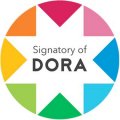
Aims and scope
Please note that SAMPJ only accepts papers that seek to contribute to sustainable development. Sustainable development is development that meets the needs of the present, without compromising the ability of future generations to meet their own needs. Submitted papers should address issues relevant to achieving the United Nations Sustainable Development Goals. Papers that do not clearly articulate how they contribute to sustainable development will be desk rejected. Papers that provide insufficient justification and/or contextual information to make them helpful in informing practice or policy will be desk rejected.
The Sustainability Accounting, Management and Policy Journal (SAMPJ) brings together research from a range of disciplinary approaches to address social and environmental sustainability challenges and the social and environmental consequences of climate change. SAMPJ seeks to contribute to practical and policy solutions to improve the impact of organisations and societies on sustainable development. The journal takes research and viewpoints from academics, practitioners and consultants in the field.
Coverage includes, but is not limited to:
- Accountability for impacts on sustainable development
- Biodiversity accounting and management
- Carbon accounting and trading
- Corporate governance and sustainable development
- Corporate strategy and sustainable development
- Economic impact of social and environmental policies
- ESG ratings and sustainable development
- Human rights and labour rights and sustainable development
- Leadership and sustainable development
- Multiple capitals and sustainable development
- Public sector accountability and sustainable development
- Race, gender, disability and LBTQI accounting
- Regulation, standards and sustainable development
- Responsible investment and sustainable development
- Smart cities and sustainable development
- Social and environmental audit
- Stakeholder engagement and sustainable development
- Sustainability accounting, accountability and reporting
- Sustainability assurance
- Sustainable development and the UN SDGs
- Sustainable development risks and opportunities
- Water accounting and management
Latest articles
These are the latest articles published in this journal (Last updated: July 2024)
Top downloaded articles
These are the most downloaded articles over the last 12 months for this journal (Last updated: July 2024)
Top cited
These are the top cited articles for this journal, from the last 12 months according to Crossref (Last updated: July 2024)

This title is aligned with our responsible management goal
We aim to champion researchers, practitioners, policymakers and organisations who share our goals of contributing to a more ethical, responsible and sustainable way of working.
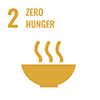

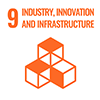
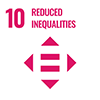
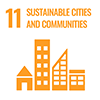
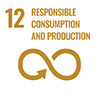
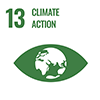
Related journals
This journal is part of our Accounting, finance & economics collection. Explore our Accounting, finance & economics subject area to find out more.
International Journal of Accounting and Information Management
International Journal of Accounting & Information Management (IJAIM) is designed as a portal to report state-of-the-art...
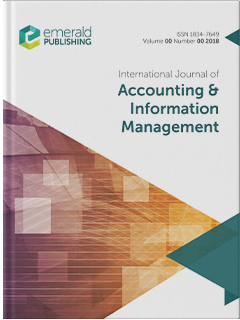
Journal of Applied Accounting Research
Journal of Applied Accounting Research (JAAR) provides a forum for the dissemination of robust academic research that...
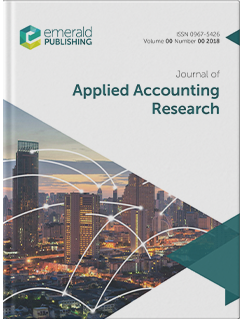
Review of Accounting and Finance
Review of Accounting and Finance publishes high-quality, original research papers that cover a wide range of topics in...
